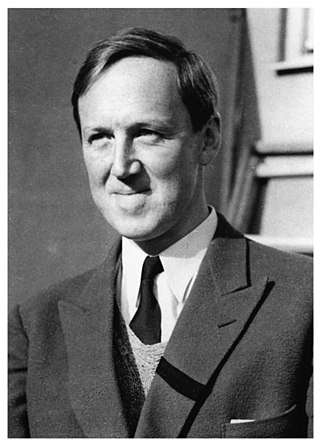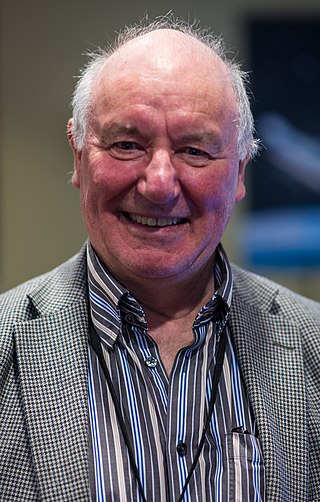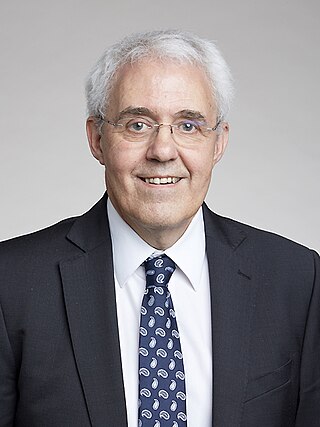Related Research Articles

Hannes Olof Gösta Alfvén was a Swedish electrical engineer, plasma physicist and winner of the 1970 Nobel Prize in Physics for his work on magnetohydrodynamics (MHD). He described the class of MHD waves now known as Alfvén waves. He was originally trained as an electrical power engineer and later moved to research and teaching in the fields of plasma physics and electrical engineering. Alfvén made many contributions to plasma physics, including theories describing the behavior of aurorae, the Van Allen radiation belts, the effect of magnetic storms on the Earth's magnetic field, the terrestrial magnetosphere, and the dynamics of plasmas in the Milky Way galaxy.

Antony Hewish was a British radio astronomer who won the Nobel Prize for Physics in 1974 for his role in the discovery of pulsars. He was also awarded the Eddington Medal of the Royal Astronomical Society in 1969.

Lyman Spitzer Jr. was an American theoretical physicist, astronomer and mountaineer. As a scientist, he carried out research into star formation and plasma physics and in 1946 conceived the idea of telescopes operating in outer space. Spitzer invented the stellarator plasma device and is the namesake of NASA's Spitzer Space Telescope. As a mountaineer, he made the first ascent of Mount Thor, with Donald C. Morton.

Malcolm Sim Longair is a British physicist. From 1991 to 2008 he was the Jacksonian Professor of Natural Philosophy in the Cavendish Laboratory at the University of Cambridge. Since 2016 he has been Editor-in-Chief of the Biographical Memoirs of Fellows of the Royal Society.
Sir Robert Wilson was a British astronomer and physicist. He studied physics at King's College, Durham and obtained his PhD at the University of Edinburgh, where he worked at the Royal Observatory on stellar spectra. His works laid the groundwork for the development of the Great Space Observatories, such as the Hubble Space Telescope.
Robert Charles Kennicutt, Jr. FRS is an American astronomer. He is currently a professor at Texas A&M University. He is a former Plumian Professor of Astronomy at the Institute of Astronomy in the University of Cambridge. He was formerly Editor-in-Chief of the Astrophysical Journal (1999–2006) and became a co-editor of the Annual Review of Astronomy and Astrophysics as of 2021. His research interests include the structure and evolution of galaxies and star formation in galaxies.
Eric Ronald Priest is Emeritus Professor at St Andrews University, where he previously held the Gregory Chair of Mathematics and a Bishop Wardlaw Professorship.
Dame Carole Jordan,, is a British physicist, astrophysicist, astronomer and academic. Currently, she is Professor Emeritus of Astrophysics at the University of Oxford and Emeritus Fellow at Somerville College, Oxford. From 1994 to 1996, she was President of the Royal Astronomical Society; she was the first woman to hold this appointment. She won the Gold Medal of the Royal Astronomical Society in 2005; she was only the third female recipient following Caroline Herschel in 1828 and Vera Rubin in 1996. She was head of the Rudolf Peierls Centre for Theoretical Physics at the University of Oxford from 2003 to 2004 and 2005 to 2008, and was one of the first female professors in Astronomy in Britain. She was made a Dame Commander of the Order of the British Empire in 2006 for services to physics and astronomy.

Richard Henderson is a British molecular biologist and biophysicist and pioneer in the field of electron microscopy of biological molecules. Henderson shared the Nobel Prize in Chemistry in 2017 with Jacques Dubochet and Joachim Frank. "Thanks to his work, we can look at individual atoms of living nature, thanks to cryo-electron microscopes we can see details without destroying samples, and for this he won the Nobel Prize in Chemistry."

Roger David Blandford, FRS, FRAS is a British theoretical astrophysicist, best known for his work on black holes.

Michele Karen Dougherty is a British astrophysicist who is a Professor of Space Physics at Imperial College London. She is leading unmanned exploratory missions to Saturn and Jupiter and is Principal Investigator for J-MAG – a magnetometer for the European Space Agency's Jupiter Icy Moons Explorer, launched in April 2023.
George Petros Efstathiou is a British astrophysicist who is Professor of Astrophysics (1909) at the University of Cambridge and was the first director of the Kavli Institute for Cosmology at the University of Cambridge from 2008 to 2016. He was previously Savilian Professor of Astronomy at the University of Oxford.
Sir William Ian Axford was a New Zealand space scientist who was director of Germany's Max Planck Institute for Aeronomy from 1974 to 1990. Axford's research was focused on the interaction of the Sun with the magnetic field of Earth (magnetosphere) or the interstellar medium (heliosphere).

Richard Edwin Hills was a British astronomer who was emeritus professor of Radio Astronomy at the University of Cambridge.

Anthony Raymond Bell is a British physicist. He is a professor of physics at the University of Oxford and the Rutherford Appleton Laboratory. He is a senior research fellow at Somerville College, Oxford.

Stanley William Herbert Cowley is a British physicist, Emeritus Professor of Solar Planetary Physics at the University of Leicester.
Cathryn N. Mitchell is a Professor of Electronic & Electronic Engineering at the University of Bath. She was awarded the 2019 Institute of Physics Edward Appleton Medal and Prize.
Janet G. Luhmann is an American physicist and senior fellow of the Space Sciences Laboratory of the University of California, Berkeley. She has made major contributions to a wide range of topics in planetary, solar, magnetospheric, and heliospheric physics. She is the principal investigator of the IMPACT instrument suite on the twin-spacecraft STEREO mission. IMPACT stands for In-situ Measurements of Particles and Coronal mass ejection (CME) Transients. It consists of a, "suite of seven instruments that samples the 3-D distribution of solar wind plasma electrons, the characteristics of the solar energetic particle (SEP) ions and electrons, and the local vector magnetic field."
Sandra C. Chapman CPhysis FInstP FRAS a British astrophysicist who is Professor of Physics and Director of the Centre for Fusion, Space and Astrophysics at the University of Warwick. Her research considers nonlinear physics and planetary magnetospheres.
Clare Watt is a British space scientist and is currently Professor of Space Physics at the Northumbria University. She was elected vice-president of the Royal Astronomical Society in 2022 and has served on the editorial board of Oxford University Press's RAS Techniques and Instruments journal since 2021.
References
- 1 2 3 "Professor Richard Horne FRS". royalsociety.org. The Royal Society. Retrieved 17 September 2024.
- ↑ "BAS scientist awarded Gold Medal by Royal Astronomical Society". British Antarctic Survey. 14 January 2022. Retrieved 17 September 2024.
- 1 2 3 4 5 "ORCID: Richard Horne". ORCID. Retrieved 17 September 2024.
- 1 2 3 4 5 6 7 "Richard B. Horne". IEEE. IEEE Xplore. Retrieved 17 September 2024.
- 1 2 "Richard Horne". Academia Europaea. Retrieved 17 September 2024.
- 1 2 "Centre for Science and Policy: Richard Horne". University of Cambridge. Retrieved 17 September 2024.
- ↑ "Professor Richard B. Horne FRS". www.st-edmunds.cam.ac.uk. St Edmund's College. Retrieved 17 September 2024.